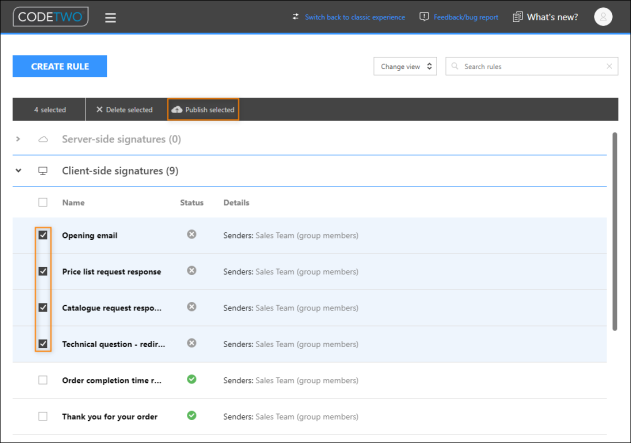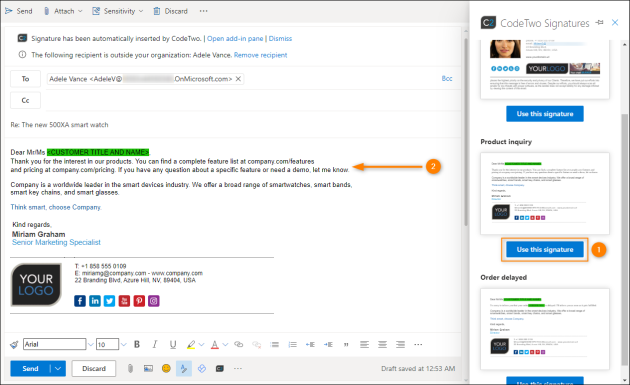How to use email signatures as canned responses
This scenario can only be used in Outlook (client-side) mode
Learn how to use CodeTwo Email Signatures 365 to provide your users with a set of ready-made response emails that they can immediately send to their clients.
When the program works in Outlook (client-side) mode, users automatically get their signature in Outlook (desktop, mobile & web) as they compose emails. They can also manually select a different signature from a set of available signatures (this works with Outlook for Windows, Mac and OWA) and have extensive control over the contents of these Outlook (client-side) signatures.
However, this feature can also be used to provide your users with more than just signatures. You can give them access to complete emails that can be used to quickly respond to standard customers’ questions and requests. This way, you make sure that all the answers provided by the employees meet the company’s standards, and that no important information is omitted. This also saves a lot of time for your users, because they no longer need to create a different response to every message from scratch. And since users can edit these canned responses before sending, a certain level of personalization is possible.
New to CodeTwo?
Learn more about signature modes our solution can work in. See how to set up your first signature rule and design an email signature template.
There are a few ways to set up canned responses in CodeTwo. Choose the option that best fits your needs:
- Set up full canned responses as email signatures
- Use CodeTwo custom attributes to create a single template for canned responses
Set up full canned responses as email signatures
First, you need to prepare templates for canned responses (emails). These can e.g. include answers for the most common questions asked by your customers.
The next step is to consider what changes your users will need to make to the emails before sending them. Clearly mark (highlight) all places in the text where additional information can be provided by a user, e.g. the name of the recipient or their company. Another good idea is to provide space for the recipient's preferred title (e.g. Ms. or Mr.) and even mark places in the text where the user should make changes to the text so that it reflects the gender of the recipient (this will be more important in some languages like German or French). As a result, the email will not read like an automatic response. A sample template might look like the one show in Fig. 1.

Fig. 1. Canned response example.
When this is done, go to app.codetwo.com and create the first Outlook (client-side) signature rule (Fig. 2.) containing a signature template that will become a canned response email. Name it accordingly, e.g. Opening email, so your users know what to expect when selecting this signature in Outlook or OWA.

Fig. 2. Creating an Outlook (client-side) signature rule.
Go to the Senders step and define rule conditions as you need. This way you can make sure that this canned email will only be available to selected users (e.g. a group of employees responsible for communication with customers). Learn more about how to configure rule conditions and exceptions
In the Logic step, deselect Set this signature as default for new messages and Set this signature as default for replies and forwards, as shown in Fig. 3. This way, when a user is typing a new message in Outlook or OWA, a canned response will be used only if it is selected.

Fig. 3. Be sure to clear these checkboxes if you don’t want your canned responses to be added to all messages in Outlook and OWA by default.
Next, go to the Design step and create a signature template. Enter the text you want to use as a canned response (as shown in Fig. 1.). When designing your template, do not forget that you also can include the standard elements of an email signature, such as a sender’s name and job position, your company’s contact details, a marketing banner, a legal disclaimer, etc. A complete signature template (canned response) is shown in Fig. 4.
Important
There is a limit of 120,000 characters for an HTML email signature. If your signature template exceeds this limit, you won't be able to add this signature to your email.

Fig. 4. A preview of a canned response containing the full email text with places to fill in and a complete signature.
When the signature template is ready, submit it by clicking Save.
Repeat the steps above to create as many canned emails (signature templates) as you need.
If you want to make all canned responses available for the same users (i.e. use the same conditions and exceptions in all signature rules), you can use the Clone button in the signature management app's main window to create an exact copy of the selected signature rule. All you need to do then is create a signature template containing the information you need.
When you are done, select all prepared signature templates and click Publish selected. This will make them available to your Outlook and OWA users.

Fig. 5. Publishing the prepared Outlook (client-side) signatures.
Now, when all your Outlook (client-side) signature rules containing canned responses are ready, the defined users will have access to several complete emails from Outlook desktop and Outlook on the web. Canned responses can be selected when composing a new email, replying to a message or forwarding one by clicking the Use this signature button in the CodeTwo Signatures pane (Fig. 6.).

Fig. 6. A list of available canned responses, accessed directly from the CodeTwo Signatures pane.
Use CodeTwo custom attributes to create a single template for canned responses
When you manage CodeTwo Email Signatures 365 for your organization, you can access our free user attribute management tool. After you sign in at attributes.codetwo.com, you can create as many CodeTwo custom attributes as you want. These attributes can keep virtually any information that comes to your mind.
You can use CodeTwo custom attributes to store:
- links to different documents you want to include in your canned responses,
- additional information (e.g. about office working hours) that is added to your communications during specific periods of year only,
- entire portion(s) of canned response’s text that differ from department to department.
As an example, let’s see how to use a CodeTwo custom attribute for the last scenario. On your website, customers can find email addresses of both your Customer Support and Marketing Teams. In the case of inquiries about products, the Support Team will be probably asked about setup instructions or solutions to issues, while questions to the Marketing Team will be mostly focused on features. That’s why, these two teams might use a similar canned response for the same product inquiry that is only slightly adjusted.
Let’s assume you’ve prepared a canned response called Product inquiry for the two departments. The content of the response is identical but for one paragraph. Here’s where a custom attribute can come into play, allowing you to store a different value (paragraph) for different team members. Thanks to that, you do not need to design two separate responses/rules (which you would normally do) but a single one only.
To learn how to deploy a canned response using a CodeTwo custom attribute, follow these general steps:
- Create a custom attribute as highlighted here, naming it e.g. Product inquiry - different paragraph.
- Bulk edit the attribute according to these instructions. Use a different value (paragraph) for each department:
- for users from Marketing Department: e.g. Thank you for the interest in our products. You can find a complete feature list at company.com/features and pricing at company.com/pricing. If you have any question about a specific feature or need a demo, let me know.
- for users from Customer Support Department: e.g. Thank you for contacting us, I'll be happy to help. Please send me the following info: device serial number and date of purchase. In the meantime, watch our short troubleshooting video which discusses the most common problems: support.company.com/device
Important
Keep in mind that the maximum length of the value to be stored in an attribute is 255 characters.
A sample edited CSV file is shown in Fig. 7. below:

Fig. 7. The CodeTwo custom attribute value for marketing users (A) and customer support users (B).
- Prepare your canned response template, as discussed at the beginning (see Fig. 1.) In the place where the paragraph that differs between the two departments is located, put the CodeTwo custom attribute’s name in curly brackets, as shown in Fig. 8.

Fig. 8. Canned response template with the CodeTwo custom attribute that will be replaced with a department-specific paragraph.
- Continue the configuration at app.codetwo.com (as described in this section). This time you do not need to create two separate canned responses for marketing and customer support departments – thanks to the custom attribute, you can handle two departments with a single rule.
Now, when a user from your Marketing Team replies to customer’s inquiry and chooses the Product inquiry signature in Outlook (Fig. 9., item 1), the custom attribute is propagated with the ‘marketing version’ of the first paragraph (Fig. 9., item 2).

Fig. 9. The ‘marketing’ version of the first paragraph is automatically inserted when a user selects the signature.
Conversely, when a Customer Support Team member replies a customer, the message will include a different first paragraph (Fig. 10.).

Fig. 10. The ‘customer support’ version of the first paragraph is automatically inserted when a user selects the signature.
In this article